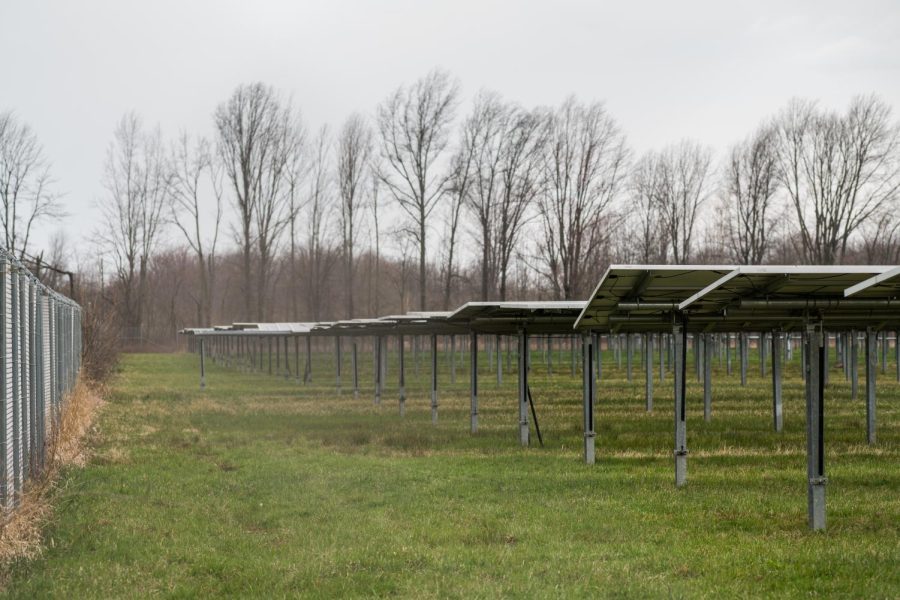OES Signs Contract with Local Farm to Bring Sheep to Mow Solar Field
The Office of Environmental Sustainability signed a contract last month with Old Slate Farm — a sheep and cut flower farm in Mount Vernon, OH — to bring sheep onto campus that will eat the grass around the College’s solar panels.
The contract will bring around 150–200 sheep to mow three times this year — tentatively once in May, once in July, and once in October — though Campus Energy and Resource Manager Joel
Baetens noted that there may be a possibility for the sheep to remain long-term in future years.
The project is being led by Baetens with support from College second-year Kira Dobbins and College first-year Shea O’Day, student interns at OES.
“I have been working in an ‘intern’ capacity since September,” Dobbins wrote in an email to the Review. “I’ve been in contact with College staff from facilities as well as with the farmers and law- yers to get this contract signed in a way that works for everyone and leaves opportunities open for the future across the board.”
Both Baetens and Dobbins independently conceived of an idea to have solar panels and agriculture sharing the same plot of land — a practice often called co-location, or agrivoltaics — on campus.
“I approached Joel separately before I knew the project had just started to be planned — I was thinking over the summer about what types of projects the College could implement on campus that would get students involved in more hands-on work,” Dobbins wrote. “I thought that having a farm or grazing under the panels would be a super cool dual land use system to exemplify how renewable energy can fit into our futures even in rural settings and how everything in the environment can have more than one purpose.”
Baetens noted that the arrangement will decrease both the financial cost and the emissions impact of maintaining the solar field. The College has historically spent between $15,000 and $30,000 per year to mow the solar field, whereas Baetens expects the sheep program to come with an annual price tag of around $6,600. While OES has yet to obtain exact numbers on carbon emissions, Baetens is confident that the plan will decrease the carbon impact of maintaining the fields.
“Less fuel is used to transport the sheep than to mow,” Baetens wrote in an email to the Review. “Also emissions per gallon are less in a truck than in a lawn mower [due] to emissions controls. We will develop [a] detailed verification analysis after we get a year of data.”
Katie Carothers, one of the owners of Old Slate Farm, outlined some of the other advantages of agrivoltaics over traditional mowing. She noted that sheep can access areas that may be difficult to mow with traditional mowers, that their manure helps to improve soil quality, and that they do not produce dust, which can cover the solar panels and reduce efficiency.
Beyond the benefits to the solar field, agrivoltaics also aids farmers. Carothers noted that these partnerships allow farmers to raise livestock that they would otherwise not have the land to graze.
“One of the biggest challenges for new and young farmers is land access, especially for those of us grazing livestock in Ohio,” Carothers wrote in an email to the Review. “Much of the land is planted in crops, not pasture.”
According to Carothers, solar fields are often planted with grass to control runoff, making them ideal grazing sites.
Oberlin’s solar field is smaller than some of the other planned agrivoltaics sites across the state that Old Slate Farm is hoping to work with, which Carothers feels makes the College a good trial run.
“Oberlin reached out to us to see about utilizing our sheep on their solar project, and we saw this as a great opportunity to begin in the industry and learn on a smaller scale before the 1000+ acre sites are built around the state,” Carothers wrote.
Beyond the suitability of the small solar field, Carothers feels that the College provides an opportunity for students to become knowledgeable about sheep farming, especially amid what she sees as the potential for growing demand for sheep farmers.
“We are … excited about student interest and involvement, as we will need more shepherds in the future as the sheep industry grows alongside solar in Ohio,” Carothers wrote.
In order to increase student and community engagement, OES is planning tours of the field while the sheep are present.
“We will talk about the Sustainable Infrastructure Program which electrifies our district energy system,” Baetens wrote. “That ties directly to onsite renewable energy generation and how to effectively manage in a low carbon way.”
Dobbins would also like for the tours to explore how the presence of the sheep can improve biodiversity in the area.
Dobbins hopes that by providing tours, OES will be able to mitigate some of the concern that large solar fields will hurt the availability of grazing land, while Baetens hopes the tours will give the College an opportunity to showcase its commitment to carbon reduction.







